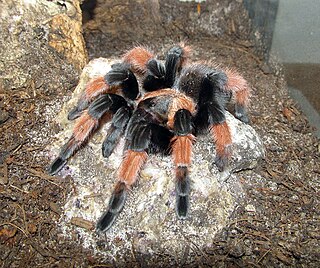
Avicularia is a genus of the family Theraphosidae containing various species of tarantulas. The genus is native to tropical Central and South America. Each species in the genus has very distinguishable pink foot pads.

Brachypelma is a genus of spiders in the family Theraphosidae (tarantulas). They may have bodies up to 6 cm long with legs of similar or greater lengths. Some species have brightly colored legs, with red or orange marks and rings.

Chromatopelma is a monotypic genus of South American tarantulas containing the single species, Chromatopelma cyaneopubescens. Commonly known as greenbottle blue tarantulas due to their metallic blue legs and blue-green carapace, they are very active and fast-growing tarantulas that are particularly attractive to hobbyists. They are native to the Paraguaná Peninsula, near Punto Fijo.

Dolichothele is a genus of spiders in the family Theraphosidae found in Brazil and Bolivia. It was first described in 1923 by Mello-Leitão. As of 2017, it contains 8 species.

Theraphosa is a genus of South American tarantulas that was first described by Tamerlan Thorell in 1870. As of May 2020 it contains three species, found in Guyana, Brazil, Venezuela, and Colombia: T. apophysis, T. blondi, and T. stirmi. They stridulate by rubbing setae on their pedipalps and legs.

Phormictopus is a genus of spiders in the family Theraphosidae (tarantulas) that occurs in the West Indies, mainly Cuba and Hispaniola, with three species probably misplaced in this genus found in Brazil and Argentina.

Tarantulas comprise a group of large and often ″hairy″ spiders of the family Theraphosidae. Currently, about 1,000 species have been identified. The term tarantula is usually used to describe members of the family Theraphosidae, although many other members of the same infraorder (Mygalomorphae) are commonly referred to as "tarantulas" or "false tarantulas". Some of the more common species have become popular in the exotic pet trade. Many New World species kept as pets have urticating hairs that can cause irritation to the skin, and in extreme cases, cause damage to the eyes.

The skeleton tarantula, Ephebopus murinus, is a species of spider belonging to the family Theraphosidae (tarantulas), sub-family Aviculariinae. A New World species, it is native to several South American countries. Its common name is derived from the skeleton-like markings on its legs.

The Malaysian earthtiger tarantula, scientific name Omothymus schioedtei, is a species of spider in the family Theraphosidae (tarantulas), found in Peninsular Malaysia. It is also known by the synonym Cyriopagopus schioedtei.
Sickius is a genus of tarantulas. It has a single species, Sickius longibulbi. It is endemic to Brazil.
The Ischnocolinae are a problematic subfamily of tarantulas. In 1892, Eugène Simon based the group, which he noted was only weakly homogeneous, on the presence of divided tarsal scopulae. This feature was later considered to be plesiomorphic, and both morphological and molecular phylogenetic studies have shown that, as traditionally circumscribed, the subfamily is not monophyletic. A much more narrowly defined Ischnocolinae sensu stricto was proposed in 2014. One of the authors of that proposal subsequently said that no further taxonomic changes should be considered until there had been a more comprehensive sampling of the subfamily. As of January 2021, the status of the Ischnocolinae remains unresolved.

Neoheterophrictus is a genus of tarantula in the family Theraphosidae. It comprises seven species, all found in India.

Aphonopelma iodius is a species of spider in the tarantula family Theraphosidae, found in United States. A 1997 paper combined it with three other previously described species into a single species, calling it "A. iodium". However, iodius is a neuter comparative adjective and is the correct form. Aphonopelma smithii has also been synonymized with A. iodius. A. iodius is common in the Mojave Desert to the west of the Colorado River. As of 1997, the distribution of A. iodius farther south or west into the Mojave Desert or North into Nevada and Utah was undetermined.
Neoheterophrictus madraspatanus is a species of spider in the family Theraphosidae, found in India.
Plesiophrictus is a genus of tarantulas that was first described by Reginald Innes Pocock in 1899.
Antillena is a genus of spiders in the family Theraphosidae (tarantulas). As of March 2017, the genus contained a single species, Antillena rickwesti, found in the Dominican Republic.
Rick C. West is a Canadian arachnologist with a main expertise toward tarantula spiders. West was born in Victoria, British Columbia. He has been interested in spiders since childhood, and collected his first tarantula, Aphonopelma eutylenum at the age of 13. He worked primarily as a Chief Constable for a local Animal Humane Society, but also have been involved with the collecting, breeding, rearing and photography of theraphosid spiders. West has traveled to over 27 countries to document and study them in their environment, has been a host, presenter and co-producer in several tarantula documentaries and has also described several new species.

Bonnetina cyaneifemur, also known as the Mexican blue femur, is a species of tarantula from the genus Bonnetina. It was first described in 2000 by Fabian Vol.
Ceratogyrus marshalli, also known as straight horned baboon or great horned baboon, is a species of tarantula from the genus Ceratogyrus. It is found in Zimbabwe and Mozambique.











